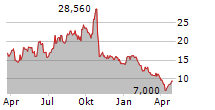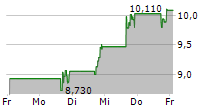
- In a preclinical HCH model, TYRA-300 demonstrated increases in long bone length and binding against the HCH altered protein-
-TYRA remains on track to submit ACH Investigational New Drug Application (IND) in 2H24-
CARLSBAD, Calif., July 2, 2024 /PRNewswire/ -- Tyra Biosciences, Inc. (Nasdaq: TYRA), a clinical-stage biotechnology company focused on developing next-generation precision medicines that target large opportunities in Fibroblast Growth Factor Receptor (FGFR) biology, today announced preclinical proof-of-concept results with TYRA-300, an investigational oral FGFR3 selective inhibitor, in hypochondroplasia (HCH). The results were presented at the 6th Annual Achondroplasia & Skeletal Dysplasia Research Conference (Pharmachon 2024), held June 28-30, 2024, in Baltimore, MD.
HCH is a skeletal dysplasia closely related to achondroplasia (ACH), the most common form of dwarfism. HCH is most commonly caused by the N540K mutation (~70-80%) in the FGFR3 gene. There are currently no approved therapeutic options for HCH. The design of TYRA-300 may inhibit the alteration driving FGFR3-related skeletal dysplasias including ACH, HCH and others.
"The new preclinical data presented at Pharmachon 2024 are very encouraging and continue to support our belief that TYRA-300 has the potential to become a best-in-class agent with the potential to address unmet medical needs for people with skeletal dysplasias," said Todd Harris, CEO of TYRA. "Developing TYRA-300 in HCH is a natural extension of our plans in ACH, and we look forward to submitting our IND in the second half of this year to support our planned Phase 2 study in pediatric achondroplasia."
In an Fgfr3Asn534Lys/+ preclinical model, TYRA-300 was evaluated in FGFR3 wild-type and mutant animals to evaluate its potential effect on long bone length and skull size compared to vehicle-treated mice. TYRA-300 was administered daily at 1.8 mg/kg/day for 21 days starting at Day 3. TYRA-300 increased the length of the appendicular skeleton in the FGFR3 mutated mice: femur by 3.70% compared to the vehicle (p<0.01); tibia by 3.75% compared to the vehicle (p<0.05); humerus by 3.22% compared to the vehicle (p<0.05); and ulna by 5.03% compared to the vehicle (p<0.01). TYRA-300 also increased the size of the foramen magnum by 5.88% (p<0.05) in mice. TYRA-300 demonstrated binding against the FGFR3 N540K altered protein and isoform selectivity for FGFR3 over other isoforms, as previously reported.
"The improvements in growth plate function observed in the hypochondroplasia mouse model provide strong proof-of-concept supporting further development of TYRA-300 for hypochondroplasia," said Dr. Michael Bober, VP, Clinical Development and Medical Affairs of TYRA. "This adds to the evidence of TYRA-300 becoming a potential precision medicine for FGFR3 mediated skeletal dysplasia."
Susana Noval Iruretagoyena, Director, Fundación ALPE, commented, "It's an exciting time for research in skeletal dysplasia and movement into hypochondroplasia. Like with achondroplasia, it will be important for companies to study more outcomes beyond height for these families."
The presentation from the 6th Annual Achondroplasia & Skeletal Dysplasia Research Conference can be accessed here.
About TYRA-300
TYRA-300 is the Company's lead precision medicine program stemming from its in-house SNÅP platform. TYRA-300 is an investigational, oral, FGFR3-selective inhibitor currently in development for the treatment of cancer and skeletal dysplasias, including achondroplasia. In oncology, TYRA-300 is being evaluated in a multi-center, open label Phase 1/2 clinical study, SURF301 (Study in Untreated and Resistant FGFR3+ Advanced Solid Tumors), which was designed to determine the recommended Phase 2 dose (RP2D) of TYRA-300, as well as to evaluate preliminary antitumor activity. In skeletal dysplasias, TYRA-300 has demonstrated positive preclinical results in achondroplasia and hypochondroplasia, and the Company expects to submit an IND in the second half of 2024 for the initiation of a Phase 2 clinical study in pediatric achondroplasia. In July 2023 and January 2024, the FDA granted Orphan Drug Designation (ODD) and Rare Pediatric Designation (RPD) to TYRA-300, respectively, for the treatment of achondroplasia.
About Tyra Biosciences
Tyra Biosciences, Inc. (Nasdaq: TYRA) is a clinical-stage biotechnology company focused on developing next-generation precision medicines that target large opportunities in FGFR biology. The Company's in-house precision medicine platform, SNÅP, enables rapid and precise drug design through iterative molecular SNÅPshots that help predict genetic alterations most likely to cause acquired resistance to existing therapies. TYRA's initial focus is on applying its accelerated small molecule drug discovery engine to develop therapies in targeted oncology and genetically defined conditions. TYRA is based in Carlsbad, CA.
For more information about our science, pipeline and people, please visit www.tyra.bio and engage with us on LinkedIn.
Forward-Looking Statements
TYRA cautions you that statements contained in this press release regarding matters that are not historical facts are forward-looking statements. The forward-looking statements are based on our current beliefs and expectations and include, but are not limited to: the potential to develop next-generation precision medicines, the potential for TYRA-300 to become a best-in-class agent and the potential safety and therapeutic benefits of TYRA-300, including the potential to inhibit the alteration driving FGFR3-related skeletal dysplasias, address unmet medical needs for people with skeletal dysplasias and become a precision medicine for FGFR3 mediated skeletal dysplasia; the potential to develop TYRA-300 in HCH; and the expected timing and phase of clinical development of TYRA-300, including timing of submission of an IND for TYRA-300 in pediatric achondroplasia. Actual results may differ from those set forth in this press release due to the risks and uncertainties inherent in our business, including, without limitation: we are early in our development efforts, have only recently begun testing TYRA-300 in clinical trials and the approach we are taking to discover and develop drugs based on our SNÅP platform is novel and unproven and it may never lead to product candidates that are successful in clinical development or approved products of commercial value; potential delays in the commencement, enrollment, data readouts and completion of preclinical studies and clinical trials; results from preclinical studies or early clinical trials not necessarily being predictive of future results, and the potential for proof-of-concept results to fail to result in successful subsequent development of TYRA-300; our dependence on third parties in connection with manufacturing, research and preclinical testing; acceptance by the FDA of INDs or of similar regulatory submissions by comparable foreign regulatory authorities for the conduct of clinical trials of TYRA-300 in pediatric achondroplasia; an accelerated development or approval pathway may not be available for TYRA-300 or other product candidates and any such pathway may not lead to a faster development process; later developments with the FDA may be inconsistent with the minutes from our prior meetings, including with respect to the proposed design of our planned Phase 2 study of TYRA-300 in pediatric achondroplasia; unexpected adverse side effects or inadequate efficacy of our product candidates that may limit their development, regulatory approval, and/or commercialization; the potential for our programs and prospects to be negatively impacted by developments relating to our competitors, including the results of studies or regulatory determinations relating to our competitors; unfavorable results from preclinical studies; we may not realize the benefits associated with ODD, including that orphan drug exclusivity may not effectively protect a product from competition and that such exclusivity may not be maintained, or from the RPD Designation, including receipt of a Priority Review Voucher or any value therefrom; regulatory developments in the United States and foreign countries; and other risks described in our prior filings with the Securities and Exchange Commission (SEC), including under the heading "Risk Factors" in our annual report on Form 10-K and any subsequent filings with the SEC. You are cautioned not to place undue reliance on these forward-looking statements, which speak only as of the date hereof, and we undertake no obligation to update such statements to reflect events that occur or circumstances that exist after the date hereof. All forward-looking statements are qualified in their entirety by this cautionary statement, which is made under the safe harbor provisions of the Private Securities Litigation Reform Act of 1995.
Contact:
Amy Conrad
[email protected]
SOURCE Tyra Biosciences




